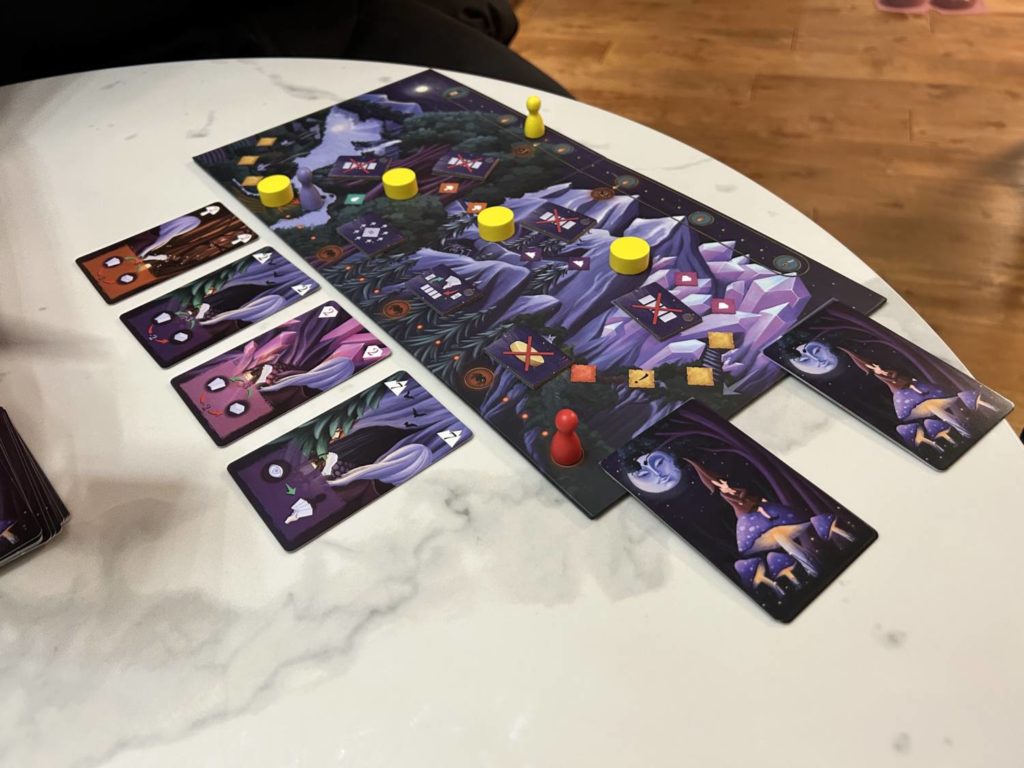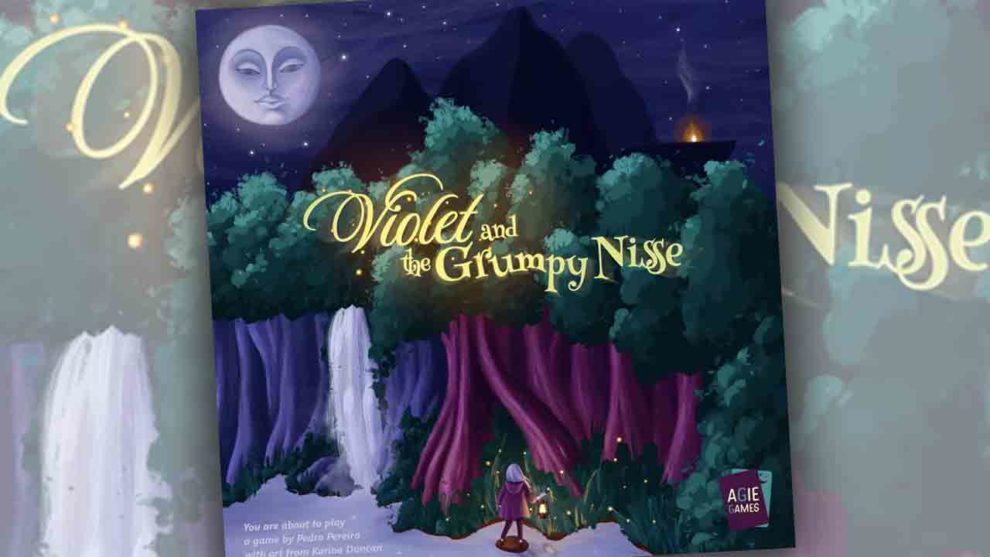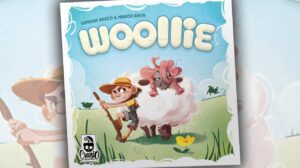Disclosure: Meeple Mountain received a free copy of this product in exchange for an honest, unbiased review. This review is not intended to be an endorsement.
In Violet and the Grumpy Nisse, one player takes the role of Violet, a young woman traveling through the nighttime forest in search of her friend Ordep. The other player is Torech, that grumpy Nisse, who has taken it upon himself to make Violet’s trip difficult. Across a series of tricks, Violet moves through the forest one spot at a time, her lantern burning through fuel, and her fear growing ever more present. She wins by making it to Ordep’s clearing on the other side, while the Nisse wins if Violet runs out of fuel or the Fear token catches up to her location.
Those tricks are a little counter-intuitive. The led suit is strongest, but the suit that matches Violet’s current location acts as a trump, unless the led card was a 6. A 1 beats any 9 regardless of suit, unless both the 1 and the 9 match the suit of Violet’s current location, because card abilities don’t activate if the card matches Violet’s location (unless it’s a 6 and it led).
This isn’t what I would normally consider good game design, and I acknowledge that. It’s inelegant at best.
If Violet wins a trick, she either advances one space and loses one lantern fuel, or stays in place and adds fuel to the lantern. If Torech wins, Violet advances one space and loses two lantern fuel. After Torech wins a second trick, the Fear token starts to move.
Violet and the Grumpy Nisse is, I have to say, a surprisingly asymmetrical game, both in terms of strategic choices and emotional experience. To play as Torech is a pleasant romp, with a bevy of options available to you. After two games in his tiny gnome shoes, I switched to Violet. That experience is way more tense. You live in a constant state of panic. It reminded me of playing as the Free Peoples in War of the Ring, of all games. Everything seems to be constantly falling apart.

Despite its inelegance, I am fascinated by Violet and the Grumpy Nisse. I can’t tell, after five games, if I’ve only started to get a sense of the skill ceiling, or if the game has peaked. Whichever is the case, I know it’s a card game where skill matters.
Players don’t draw cards blind from the deck. Four cards are dealt out into a market, and you make your selections from there. Card counting is essential to playing well. So is judging when to prioritize playing a card for its effect over playing a card to win. The changing suits of the locations on the map contour the experience, encouraging different suits and different numbers as Violet moves along.
I can forgive Violet and the Grumpy Nisse its ungainliness because the game needs all these weird bits sticking out of the edges. It may be fine. It may also be an absolute triumph of design. I cannot tell. I hold two contradictory moods in my head at once: I know my last game felt exhilaratingly intentional, and I know I don’t want to teach it to anyone new ever again.

Violet and the Grumpy Nisse was inspired by Pedro Pereira’s experience as a father. Pedro (Ordep) and his wife, Violette (Violet), used to travel internationally for work, enjoying one another’s company along with their mutual independence. Then they had Hector (Torech). Suddenly that independence was taken away.
Growing up, I never questioned that I would have children. I love their curiosity and joy. I love the way showing them how to be people makes me into the best version of myself. I always assumed I would have one or two of my own. The first dent was, and is, climate change. We don’t have to go into that here.
The other dent can be viewed as either selfish or practical. Perhaps both. I don’t have the time or the money to do the things I want to do as it is. The western way of child-rearing, where every family is in it for themselves, is brutal and unforgiving. I just don’t know.
There is beauty and honesty in acknowledging that what formed the core of Pedro and Violette’s relationship was fundamentally altered, perhaps even stripped away, by having a child. I appreciate and identify with the questions and reflection that led to Violet and the Grumpy Nisse. Violet just wants to get through the forest and spend a little time with Ordep, but she can’t. Not like she used to.











Thank you so much for your review Andrew. Loved reading it despite (or because of?) its ambiguity on how you feel about Violet and the Grumpy Nisse. I do appreciate your interest in it, and that you took the time to play it.
My favourite part of course was the comparison to War of the Ring haha! Brilliant!
The part were you explain the tricks seems more convoluted than needs be though:
You explain the card powers as if they were exceptions to the rules, when in fact they, like in all games with powers, just override the ground rules. You even use the expression “except if”, but it’s not an exception. The rule is always the same: leading suit is beaten only by trump, or higher card of same suit. The card powers can override this rule.
You also explained correctly that “card abilities don’t activate if the card matches Violet’s location” but then you added “(unless it’s a 6 and it led)”. This is technically incorrect although the
end result is the same, because a 6 trump can only be beaten by another trump value 7 or higher, just like a 4 trump can only be beaten by another trump 5 or higher for example. So again, the 6 as a trump is not an exception to the rule despite what it might seem at first. If you want to go really deep into detail, what the example with the 6 means is that if you play a trump 6 that can only be beaten by 7, 8 or 9 of trump suit, there then are 11 other trump cards in the deck (including the wild 5s), whereas if you play a non trump 6, that can also be beaten also by 7, 8 or 9 of that same non-trump suit, you actually still have 12 trumps in the deck. Tiny details to explain another tiny detail, but that can ultimately make a big difference in how you explain the game to someone new, or how cumbersome explaining it might seem to you.
I’m highlighting this because it’s obviously relevant to me, but also to encourage you to try explain it to someone new again, just maybe with a slightly different understanding of how you can go about explaining it: ground rules + overriding powers VS ground rules + exceptions (which sounds a lot more complicated than it is).
As for the inspiration for the theme, we of course love our small family and wouldn’t ever dream of changing anything. We also do not lament the way it changed when we got our son. This aspect was something we wanted to reflect on though because having and managing a family can be draining and sometimes we yearn for a time in our life where we had more opportunities to play games for example. We still travel a lot with our son of course. The paradox is of course that if a couple with children does get to play the game, they are actually spending quality time together, playing a game about lack of quality time together 🙂
Thank you very much for your comment, Pedro! I think Violet & the Grumpy Nisse is a fascinating design, and I was very happy to spend time with it. The comparison to War of the Ring is deserved! The two different sides feel entirely different. I look forward to reviewing whatever you may come up with in the future.
I apologize if I seem to have implied that you are not happy with your family as it is, that wasn’t my intention. I assumed it to be exactly as you say, that sometimes you yearn for the way things used to be. If that portion of the piece reads as overly negative, it is only a reflection of my own anxieties about the subject. I am not likely to be having children any time soon, though.
Thanks again for your reply Andrew. And thanks for the kind words about the game design (although fascination can go both ways!). Interestingly, I recently stumbled on this video here: https://www.youtube.com/watch?v=CSeZZNcVnpA
It’s French but the reviewer said about Violet and the Grumpy Nisse that the design is very elegant. It’s fun to see how different people think differently about the same aspects of the game design.
Thanks again for the well-written review.